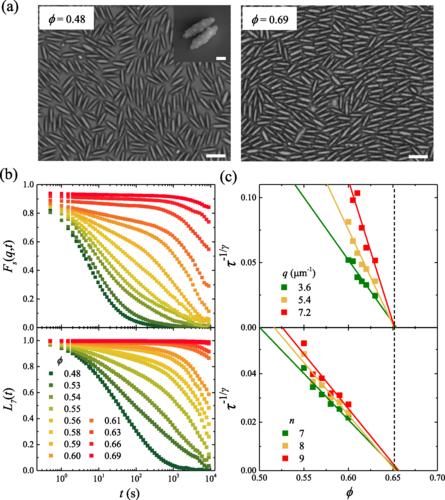Glass Transition in Monolayers of Rough Colloidal Ellipsoids
Jian Liang1,* Xuan Feng2,* Ning Zheng3, Huaguang Wang1(王华光)*, Ran Ni2(倪冉)*,Zexin Zhang1,4(张泽新)*
1College of Chemistry, Chemical Engineering and Materials Science, Soochow University, Suzhou 215123, China
2School of Chemistry, Chemical Engineering and Biotechnology, Nanyang Technological University,62 Nanyang Drive, 637459, Singapore
3School of Physics, Beijing Institute of Technology, Beijing 100081, China
4Institute for Advanced Study, Center for Soft Condensed Matter Physics and Interdisciplinary Research,School of Physical Science and Technology, Soochow University, Suzhou 215006, China
Phys. Rev. Lett.2025, 134, 038202
Abstract: Structure-dynamics correlation is one of the major ongoing debates in the glass transition, although a number of structural features have been found connected to the dynamic heterogeneity in different glass-forming colloidal systems. Here, using colloidal experiments combined with coarse-grained molecular dynamics simulations, we investigate the glass transition in monolayers of rough colloidal ellipsoids. Compared with smooth colloidal ellipsoids, the surface roughness of ellipsoids is found to significantly change the nature of glass transition. In particular, we find that the surface roughness induced by coating only a few small hemispheres on the ellipsoids can eliminate the existence of orientational glass and the two-step glass transition found in monolayers of smooth ellipsoids. This is due to the surface roughness-induced coupling between the translational and rotational degrees of freedom in colloidal ellipsoids, which also destroys the structure-dynamics correlation found in glass-forming suspensions of colloidal ellipsoids. Our results not only suggest a new way of using surface roughness to manipulate the glass transition in colloidal systems, but also highlight the importance of detailed particle shape on the glass transition and structure-dynamics correlation in suspensions of anisotropic colloids.

Article information: //doi.org/10.1103/PhysRevLett.134.038202